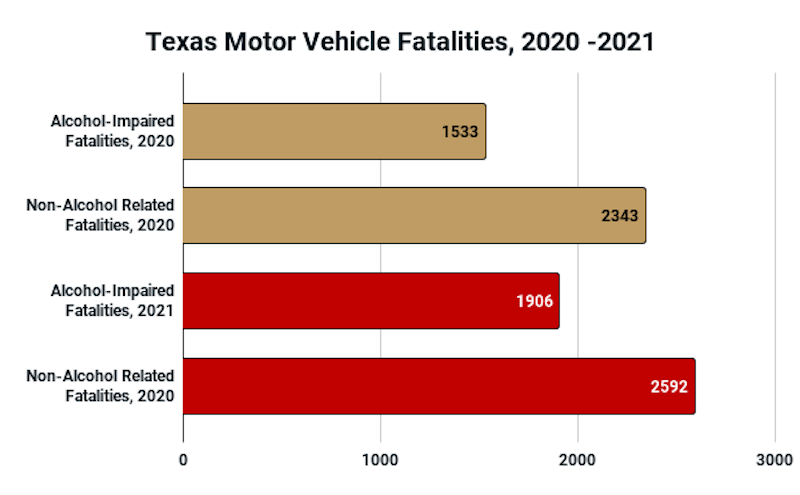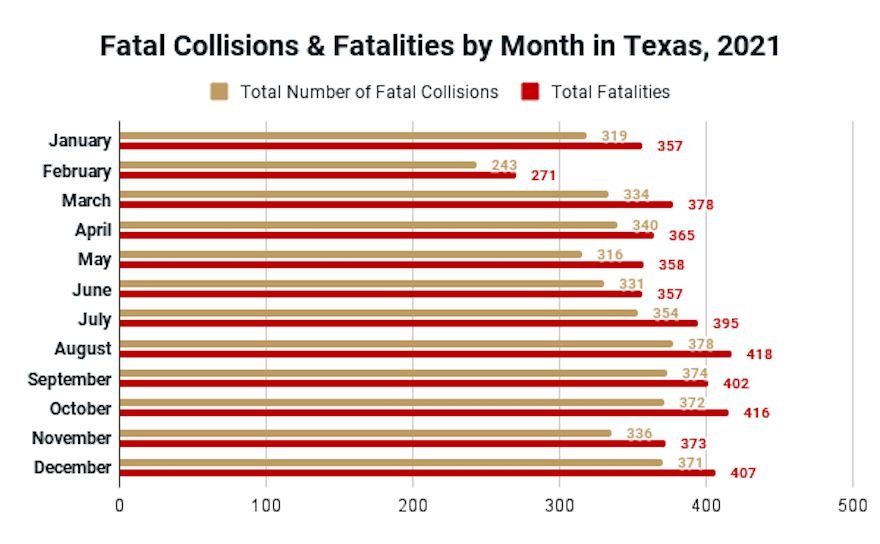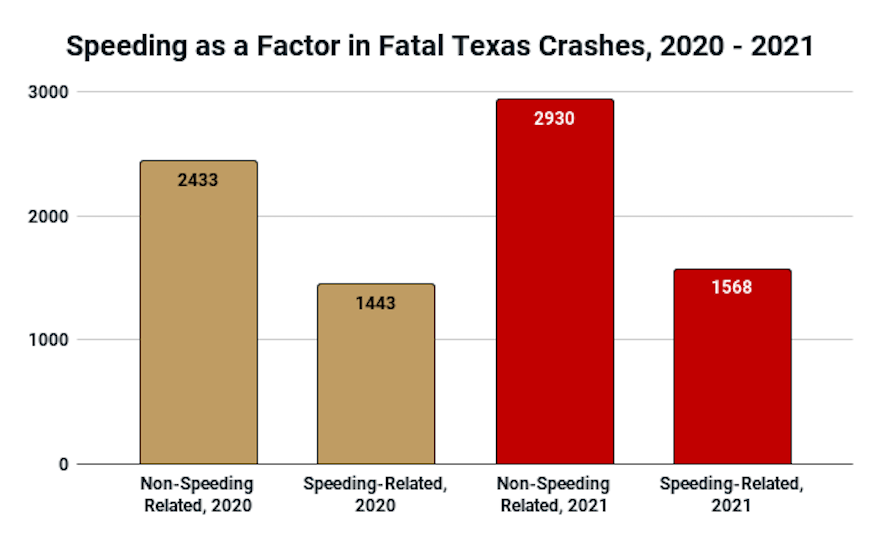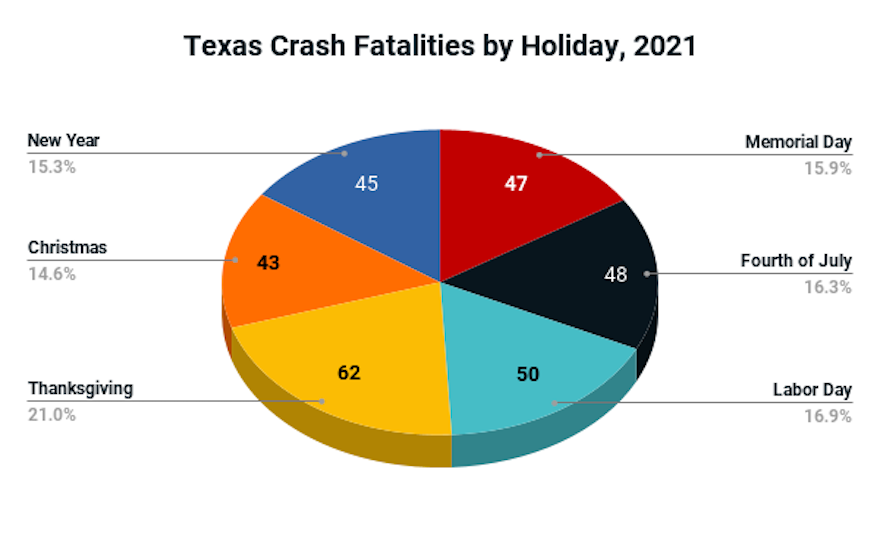Since 2000
Texas Car Crash Statistics & Fast Facts [2023]
Vehicle accidents are not uncommon in Texas. In fact, Texas is one of the states with the highest death rates on the roadways of any other state in the country. Here, we want to examine the most recent crash data available for the state of Texas and relay relevant statistics to you. We hope that, with this information, you can understand the dangers associated with operating a vehicle and continue to practice strong defensive driving skills to keep yourself and your loved ones safe. If you are involved in a collision, speak to a Houston car accident attorney as soon as you are able to.
Article Summary
In this article, we took a look at Texas car crash data from 2020 and 2021, the most recent years for which we have a complete database of collision statistics for the state. We observed an increase (16%) in the number of total roadway fatalities in the state over that two-year period. Disturbingly, we noticed that alcohol-related crash fatalities increased by 24% over that same time, suggesting that drinking and driving may be more prevalent. Pedestrians (817), motorcyclists (515), and bicyclists (91) saw particularly high numbers of fatalities throughout 2021.
Table of Contents
To immediately access the data at any of the sections of this webpage, click the corresponding links below.
Shift in Fatalities from 2020 to 2021
First Harmful Event in Rural Crashes
First Harmful Event in Urban Crashes
Road Conditions for Rural Crashes
Road Conditions for Urban Crashes
Fatal Texas Crashes by Month & Road Type
Groups at Highest Risk of Fatal Harm in a Crash
Fatal Crashes by Vehicle Type
Speeding as a Factor in Lethal Collisions
Seatbelt Usage & Crash Statistics
Fatal Motorcycle Crashes in 2021
Deadliest Texas Holiday Periods in 2021
Steps to Follow After a Car Crash
Speak to a Lawyer Today
How Did Texas Traffic-Related Fatalities Shift From 2020 to 2021?
In 2020, the total number of roadway fatalities in Texas equaled 3,876. Unfortunately, there were 622 more fatalities in 2021, with a total of 4,498 that year. This represented an increase of 16%.
While Texas has typically been near the top of the list with total fatalities each year, the increase from 2020 to 2021 was quite large. If we look closer at the data, we can see that there was a 24% increase in the total number of alcohol-related roadway fatalities from 2020 to 2021. This was an increase of 373 from one year to the next, and the fatalities related to alcohol seem to be the contributing factor to the increase in overall roadway deaths between the two years.

First Harmful Event in Rural Texas Crashes
Both rural and urban areas of Texas come with their own hazards. However, the causes of crashes between the two vary in some ways. Here, we want to examine the first harmful event for recorded fatal rural collisions in 2021, the most recent reporting year on file:
- Animal – 14
- Fixed object – 532
- Motor Vehicle in transport – 890
- Other non-collision – 19
- Other object – 13
- Overturned – 255
- Parked car – 27
- Pedalcyclist (bicyclist) – 28
- Pedestrian – 225
- Railroad/train – 7
First Harmful Event in Urban Texas Crashes
Urban areas of the state saw some differences concerning the first harmful event for fatal collisions in 2021. While many of the numbers below are comparable to the rural data listed above, we primarily see an increase in the number of pedestrian and bicyclist incidents. This does make sense, considering urban areas are where vulnerable motorists are more likely to be in close proximity to motor vehicles.
- Animal – 2
- Fixed object – 518
- Motor Vehicle in transport – 794
- Other non-collision – 15
- Other object – 4
- Overturned – 98
- Parked car – 34
- Pedalcyclist (bicyclist) – 61
- Pedestrian – 530
- Railroad/train – 2
Road Conditions for Rural Texas Crashes
Roadway conditions often play a role in vehicle accidents, in both rural and urban areas of the state. Data from the Texas Department of Transportation shows that the following roadway conditions were present in rural crashes in 2021:
- Dry – 120,783
- Ice – 2,852
- Sand, mud, dirt – 976
- Slush – 326
- Snow – 715
- Standing water – 1,168
- Wet – 18,790
- Other – 228
- Unknown – 305
Road Conditions for Urban Texas Crashes
Examining the roadway conditions for 2021 Texas urban area collisions, we can see one overwhelming factor – there are many more crashes in the urban areas of the state than in the rural areas. Proportionately, the roadway conditions remain similar between the two, but there were certainly fewer collisions due to sand, mud, and dirt in urban parts of the state.
- Dry – 351,656
- Ice – 4,080
- Sand, mud, dirt – 263
- Slush – 476
- Snow – 1,064
- Standing water – 1,170
- Wet – 44,043
- Other – 274
- Unknown – 2,821
Breakdown of Fatal Texas Crashes by Month & Road Type
When examining the total number of fatal collisions across the state in 2021, we see that the numbers remain relatively consistent from month to month. The following represents the total number of fatal collisions and fatalities by month that year:

Though August was the month with the most fatal collisions, other months were relatively close. February had the fewest fatal collisions, but it is important to remember that February is shorter than other months, and this likely contributes to part of the discrepancy.
When we examine the types of roadways where Texas drivers are most likely to experience a fatal collision, we can see that US and state highways top the list month after month. Aside from highways, city streets were the areas most likely to see fatal crashes, followed by roads taking people from a farm to the market, interstates, and county roadways.
Who Was Most Likely to Suffer Deadly Injuries in a Crash in 2021?
There are many vulnerable roadway users, including motorcyclists, pedestrians, and bicyclists. These individuals are much more likely to sustain severe injuries in the event they collide with another vehicle or a fixed object. In 2021, the following number of fatalities occurred in these groups:
- Motorcyclists – 515
- Pedestrians – 817
- Bicyclists – 91
For each of these vulnerable roadway user categories, the total number of fatalities in 2021 rose above 2020 numbers.
What Types of Vehicles Were Most Likely to be Involved in Lethal Crashes?
There are various types of vehicles that traverse Texas roadways each day. Most of these are passenger vehicles, but there are several other types of vehicles that serve the community, like police cars, commercial trucks, utility trucks, etc. Here, we want to examine the types of vehicles involved in 2021 fatal collisions:
- Passenger cars – 2,280
- Pickup trucks – 1,1588
- SUVs – 1,192
- Trucks (non-pickup) – 169
- Semi-trailers – 536
- Fire trucks – 2
- Police vehicles – 15
- Motorcycles – 546
- Vans – 177
- Buses – 16
Speeding as a Factor in Lethal Collisions
Year after year, speeding is a leading cause of fatal accidents in Texas and throughout the US. In 2021 there were 1,568 total speeding-related accidents in the state, according to the NHTSA. This represented 35% of all fatal collisions in Texas that year.
In 2020, the number of speeding-related collisions in the state was 1,443. Even though this was fewer than in 2021, the 2020 total represented 37% of all fatal collisions that year. Despite the increase in fatalities caused by speeding-related crashes from 2020 to 2021, non-speeding crashes had a higher rate of lethal injuries in both years. However, less drivers may be inclined to drive at high speeds, reducing the chances of a speeding-related crash occurring.

Did Seatbelt Usage Have an Impact on Injuries Suffered in Texas Crashes?
It should come as no surprise that seatbelts save lives, which is why the state law requires everyone in a vehicle to wear one. During 2021, there were 1,422 total fatalities of drivers or occupants who wore a seatbelt and 1,236 fatalities among those who did not have a seatbelt on at the time of the collision.
However, it is hard to draw conclusions based on these numbers alone. Even though more fatalities happened to those who were restrained, there were far more collisions amongst that particular group, so the numbers are skewed higher. Most people do wear their seatbelts, and those who do not are much more likely to sustain a fatal or serious injury collision.
The Importance of Seatbelt Usage to Reduce Traffic Fatalities
Data from the Centers for Disease Control and Prevention (CDC) shows that more than half of nationwide traffic fatalities during a counted year were among those who were not restrained by a seatbelt when the collision occurred. The CDC states that wearing a seatbelt is the most effective way to prevent serious injuries or death in a crash.
Data shows that wearing a seatbelt can reduce the risk of death by 45% and the risk of serious injuries by 50%.
Fatal Crashes Involving Motorcycles in Texas in 2021
Motorcyclists are more vulnerable on the roadway, even more so than other vulnerable roadway users such as pedestrians and bicyclists. In 2021, there were 522 total motorcyclist fatalities. When we examine the data a bit further, we see that there were 502 motorcycle driver fatalities. Amongst those, a helmet was not worn in 227 of the incidents.
Motorcycle Helmet Laws in Texas
The motorcycle helmet law in Texas can be confusing and varies according to the age of the rider. In this state, anyone under the age of 21 is required to wear a motorcycle helmet when riding. Those 21 and over do not have to wear a helmet as long as they meet an eligible helmet exemption. The exemptions include:
- The rider carries health insurance
- The health insurance covers medical bills in the event a motorcycle accident occurs
- The insurance card should say “Motorcycle Health”
Even though not every motorcyclist is required to wear a helmet, the use of these safety devices is strongly recommended.
Which Holidays Saw the Most Deadly Crashes in Texas in 2021?
The holidays typically result in an increase in deadly crashes across the state. When compiling and displaying the data for each holiday, please know that the count includes the days surrounding the holiday, so it is really an approximate three- or four-day total for each. Although many people expect New Year’s Eve or Memorial Day to be among the deadliest holidays for drivers, the period with the most fatalities in Texas in 2021 was actually around Thanksgiving. The following is the number of fatal collisions for several major holidays:
- Memorial Day – 47 fatalities
- Fourth of July – 48 fatalities
- Labor Day – 50 fatalities
- Thanksgiving – 62 fatalities
- Christmas – 43 fatalities
- New Year – 45 fatalities

What Steps Should You Follow After a Car Crash in Texas?
There are various steps that Texas drivers can take shortly after a collision occurs. These steps, first and foremost, help ensure the well-being of those involved. The steps can also help maintain the integrity of any claim against an at-fault party that may arise.
- Seek medical care. Medical attention is crucial, even if the injuries are not immediately noticeable. Often, the signs and symptoms of crash injuries occur hours or even days after the incident. Prompt medical care helps establish a solid link between the incident and any injuries that arise in the immediate aftermath and the days following the crash.
- Call the police. The police need to come to the scene to conduct an investigation. A police report is needed in order to move forward with an insurance claim, and it is not uncommon for the responding officer to indicate who they think caused the crash. Additionally, if there were any traffic violations that caused the incident, the police will write the citation.
- Gather evidence. Evidence wins cases, but we do understand the challenges associated with gathering evidence immediately after a crash. We recommend using a cell phone or another type of camera to document the scene. This can include taking photographs of vehicle damage, causes of the crash, license plate numbers, debris and skid marks, injuries, and more. If there were eyewitnesses or individuals in other vehicles that stopped, try to get their names and contact information written down.
- Call an attorney. You should speak to a car accident attorney for help as soon as possible. When you work with a lawyer, you will have an advocate ready to step in and investigate the incident and handle all communication with insurance carriers. Your attorney will negotiate on your behalf and even take your case to court if needed. Many attorneys work on a contingency fee basis, which means you pay nothing unless the attorney wins your case.
- Continue medical care. All car accident victims should continue medical treatment until their doctor releases them. This could take weeks or even months. Discontinuing care before a medical professional recommends doing so could give the insurance claims adjuster or at-fault party legal team a reason to delay or deny the claim.
Be Safe and Contact an Attorney After a Crash
If you or somebody you love has been injured in a vehicle accident caused by the negligence of another driver in Texas, we encourage you to reach out to a Houston personal injury attorney for assistance with your case. These claims can be challenging, particularly when it comes to dealing with insurance carriers and aggressive at-fault parties. You deserve compensation for your losses, including coverage of your medical bills, lost income, and pain and suffering. Reach out for a free consultation today.
Request Free Consultation
"*" indicates required fields
Practice Areas
- Houston Personal Injury Lawyer
- Airbag Defect
- Amusement Park Accidents
- Aviation Accidents
- Bicycle Accidents
- Birth Injuries
- Boating Accidents
- Burn Injuries
- Bus Accidents
- Car Accidents
- Catastrophic Injuries
- Child Molestation Victims’ Lawyer
- Construction Accidents
- Crane Accidents
- Distracted Truck Driving
- Drowning
- Drunk Driving Accidents
- Elevator Accidents
- Fraternity Hazing
- Heavy Machinery Accidents
- Hunting Accidents
- Industrial Accidents
- Loss of Limb/Amputation Injuries
- Lyft Accidents
- Motorcycle Accidents
- Oil Refinery Accidents
- Pedestrian Accidents
- Pemex Chemical Release Injury Lawyer
- Plant Explosion
- Premises Liability
- Product Liability
- Railroad and Train Accident
- Sexual Abuse & Assault Attorney
- Spinal Cord Injury
- Truck Accidents
- Truck Tire Blowout Accidents
- Truck Underride Accident
- Rideshare Accidents
- Uber Accidents
- Vietnamese Car Accidents
- Vietnamese Truck Accidents
- Vietnamese Wrongful Death
- Workplace Injuries
- Wrongful Death
Categories
- 3M
- Adult Survivors of Sexual Abuse
- Aircraft accident
- Amazon Truck Accident
- Amusement Park Injury
- Aquatic Accidents
- Asphalt Accident
- Austin Car Accident
- Austin Injury
- Beach Accident
- Boating Accident
- Boy Scouts
- Boy Scouts Sexual Abuse
- Brain Injury
- Broken Bones
- Buried Alive
- Burn Injuries
- Burn Injury
- Bus Accidents
- Business Insurance
- CAEv3
- Car Accident
- Carbon Monoxide Poisoning
- Cargo Accident
- Catastrophic Injury
- CBD
- Chemical Plant Accident
- Child Care
- Child Sexual Abuse
- Chlorine Gas Leak
- Class Action Lawsuits
- Clergy Sexual Abuse
- Community Involvement
- Construction Accident
- Consumer Product Injury
- Crane Collapse
- Crane Collapse Dallas Texas
- Daycare
- Defective Drugs
- Defective Products
- Distracted Driving
- Dock Accident
- Dog Mauling
- Drowning Accident
- Drug Injury
- Drunk Driving
- E. Coli Outbreaks
- Earplugs
- Elder Abuse
- Electrocution
- Elevator Accidents
- Explosion Accident
- Fall Injuries
- Felony
- Firm News
- Fishing Accident
- Food Poisoning
- Fraternity Hazing
- Gas Rig Accident
- Head Injury
- Helicopter Accident
- HomeOwner Insurance
- Hot Tub Accident
- Houston Personal Injury Attorney
- Hurricane Insurance
- In the News
- Industrial Accident
- Insurance
- Intoxication Manslaughter
- Jones Act
- Lake Drowning
- Lathe Accident
- Medical Device Failure
- Medical Malpractice
- Medical Marijuana
- Motorcycle Accident
- Murder
- Natural Gas Rig Explosion
- Nursing Home Abuse
- Offshore Injuries
- Oil Refinery Explosion
- Oil Rig Accident
- Oil Rig Explosion
- Oil Slicks
- Oil Spills
- Pedestrian Accident
- Personal Injury
- Pick Up Truck Accident
- Pipeline Explosion
- Plane Accidents
- Plant Explosion
- Pond Drowning
- Pool Accidents
- Pool Operator Negligence
- Railroad Accidents
- River Drowning
- Salmonella Outbreak
- Scaffold Accidents
- School Pool Accidents
- Sexual Abuse by Catholic Priests
- Sexual Abuse by Doctors
- Sexual Assault
- Shooting Accident
- Slip and Falls
- Spanish
- Spinal Injury
- Sports Hazing
- Toxic Gas Injury
- Traffic Accident
- Train Injury
- Traumatic Brain Injury Lawyer
- Trip and Falls
- Truck Accident
- Uncategorized
- Vehicular Homicide
- Vehicular Manslaughter
- Water Injury
- Welcome to our Blog
- Wildfire
- Wildfire
- Workers' Compensation
- Workplace Injury
- Wrongful Death
Archive
- October 2025
- September 2025
- June 2025
- May 2025
- April 2025
- January 2025
- November 2024
- October 2024
- June 2024
- April 2024
- March 2024
- February 2024
- January 2024
- December 2023
- November 2023
- October 2023
- September 2023
- August 2023
- July 2023
- May 2023
- April 2023
- February 2023
- January 2023
- December 2022
- November 2022
- August 2022
- July 2022
- May 2022
- February 2022
- January 2022
- December 2021
- November 2021
- October 2021
- August 2021
- July 2021
- May 2021
- April 2021
- March 2021
- February 2021
- December 2020
- November 2020
- October 2020
- September 2020
- August 2020
- July 2020
- June 2020
- May 2020
- April 2020
- March 2020
- February 2020
- January 2020
- December 2019
- November 2019
- October 2019
- September 2019
- August 2019
- July 2019
- June 2019
- May 2019
- April 2019
- March 2019
- February 2019
- January 2019
- December 2018
- November 2018
- October 2018
- September 2018
- August 2018
- July 2018
- June 2018
- May 2018
- April 2018
- March 2018
- February 2018
- January 2018
- December 2017
- November 2017
- October 2017
- September 2017
- August 2017
- July 2017
- June 2017
- May 2017
- April 2017
- March 2017
- February 2017
- January 2017
- December 2016
- November 2016
- October 2016
- September 2016
- August 2016
- May 2016
- January 2016
- December 2015
- May 2015
- August 2013
- February 2013
- July 2012
- February 2012
- September 2011
- August 2011
- July 2011
- June 2011
- May 2011
- April 2011
- March 2011
- February 2011
- January 2011
- December 2010
- November 2010
- October 2010
- September 2010
- July 2010
- June 2010
- May 2010
"*" indicates required fields